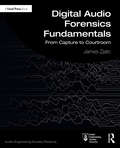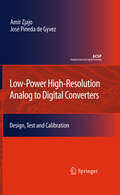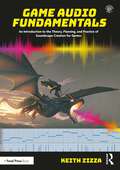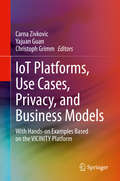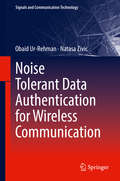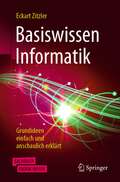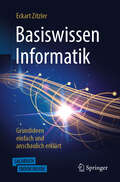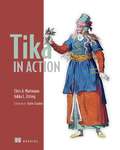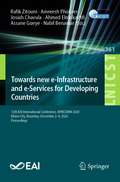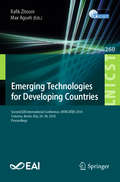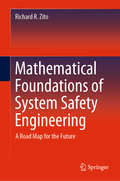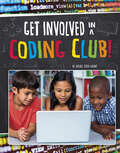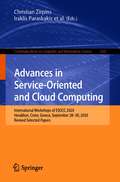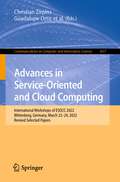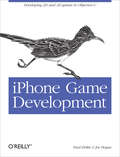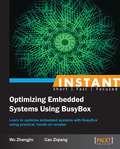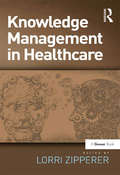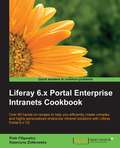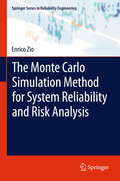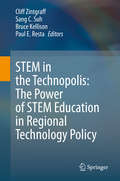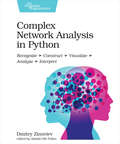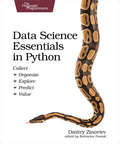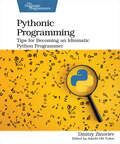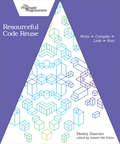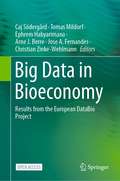- Table View
- List View
Digital Audio Forensics Fundamentals: From Capture to Courtroom (Audio Engineering Society Presents)
by James ZjalicDigital Audio Forensics Fundamentals offers an accessible introduction to both the theory and practical skills behind this emerging field of forensic science. Beginning with an overview of the history of the discipline, the reader is guided through forensic principles and key audio concepts, before being introduced to practical areas such as audio enhancement, audio authentication, and the presentation of reports. Covering all aspects of audio forensics from the capture to the courtroom, this book is pivotal reading for beginners entering the field, as well as experienced professionals looking to develop their knowledge of the practice.
Low-Power High-Resolution Analog to Digital Converters
by Amir Zjajo José Pineda de GyvezWith the fast advancement of CMOS fabrication technology, more and more signal-processing functions are implemented in the digital domain for a lower cost, lower power consumption, higher yield, and higher re-configurability. This has recently generated a great demand for low-power, low-voltage A/D converters that can be realized in a mainstream deep-submicron CMOS technology. However, the discrepancies between lithography wavelengths and circuit feature sizes are increasing. Lower power supply voltages significantly reduce noise margins and increase variations in process, device and design parameters. Consequently, it is steadily more difficult to control the fabrication process precisely enough to maintain uniformity. The inherent randomness of materials used in fabrication at nanoscopic scales means that performance will be increasingly variable, not only from die-to-die but also within each individual die. Parametric variability will be compounded by degradation in nanoscale integrated circuits resulting in instability of parameters over time, eventually leading to the development of faults. Process variation cannot be solved by improving manufacturing tolerances; variability must be reduced by new device technology or managed by design in order for scaling to continue. Similarly, within-die performance variation also imposes new challenges for test methods. In an attempt to address these issues, Low-Power High-Resolution Analog-to-Digital Converters specifically focus on: i) improving the power efficiency for the high-speed, and low spurious spectral A/D conversion performance by exploring the potential of low-voltage analog design and calibration techniques, respectively, and ii) development of circuit techniques and algorithms to enhance testing and debugging potential to detect errors dynamically, to isolate and confine faults, and to recover errors continuously. The feasibility of the described methods has been verified by measurements from the silicon prototypes fabricated in standard 180nm, 90nm and 65nm CMOS technology.
Game Audio Fundamentals: An Introduction to the Theory, Planning, and Practice of Soundscape Creation for Games
by Keith ZizzaGame Audio Fundamentals takes the reader on a journey through game audio design: from analog and digital audio basics to the art and execution of sound effects, soundtracks, and voice production, as well as learning how to make sense of a truly effective soundscape. Presuming no pre-existing knowledge, this accessible guide is accompanied by online resources – including practical examples and incremental DAW exercises – and presents the theory and practice of game audio in detail, and in a format anyone can understand. This is essential reading for any aspiring game audio designer, as well as students and professionals from a range of backgrounds, including music, audio engineering, and game design.
IoT Platforms, Use Cases, Privacy, and Business Models: With Hands-on Examples Based on the VICINITY Platform
by Carna Zivkovic Yajuan Guan Christoph GrimmThis book provides a comprehensive and consistent introduction to the Internet of Things. Hot topics, including the European privacy legislation GDPR, and homomorphic encryption are explained. For each topic, the reader gets a theoretical introduction and an overview, backed by programming examples. For demonstration, the authors use the IoT platform VICINITY, which is open-source, free, and offers leading standards for privacy. Presents readers with a coherent single-source introduction into the IoT;Introduces selected, hot-topics of IoT, including GDPR (European legislation on data protection), and homomorphic encryption;Provides coding examples for most topics that allow the reader to kick-start his own IoT applications, smart services, etc.
Noise Tolerant Data Authentication for Wireless Communication (Signals And Communication Technology)
by Natasa Zivic Obaid Ur-RehmanThis book provides insight into the challenges in providing data authentication over wireless communication channels. The authors posit that established standard authentication mechanisms – for wired devices – are not sufficient to authenticate data, such as voice, images, and video over wireless channels. The authors propose new mechanisms based on the so-called soft authentication algorithms, which tolerate some legitimate modifications in the data that they protect. The authors explain that the goal of these algorithms is that they are tolerant to changes in the content but are still able to identify the forgeries. The authors go on to describe how an additional advantage of the soft authentication algorithms is the ability to identify the locations of the modifications and correct them if possible. The authors show how to achieve this by protecting the data features with the help of error correcting codes. The correction methods are typically based on watermarking, as the authors discuss in the book.Provides a discussion of data (particularly image) authentication methods in the presence of noise experienced in wireless communication;Presents a new class of soft authentication methods, instead of the standard hard authentication methods, used to tolerate minor changes in image data;Features authentication methods based on the usage of authentication tags as well as digital watermarks.
Basiswissen Informatik: Grundideen einfach und anschaulich erklärt
by Eckart ZitzlerDieses reich bebilderte Sachbuch bietet Ihnen einen einfachen, aber fundierten Einstieg in das Gebiet der Informatik und erklärt Schritt für Schritt, wie Computer und Internet funktionieren. In 18 Kapiteln werden die Schlüsselbegriffe, die der Computertechnologie zugrunde liegen, in überschaubaren Portionen erläutert. Dabei wird bewusst auf technische Details, Formeln und komplizierte Definitionen verzichtet, der Fokus liegt auf dem Verstehen der Ideen. Es geht um digital und analog, die innere Funktionsweise und den Aufbau von Computern, um Codierung, Programmiersprachen, Algorithmen und Datenstrukturen, um die Prinzipien und die Nutzung des Internets sowie um Künstliche Intelligenz, Verschlüsselung und Sicherheit. Das Buch ist in drei Teile untergliedert und führt vom Einsteigen über das Vertiefen zum Durchdringen. Es richtet sich an alle, die ein Basiswissen in Informatik erwerben und hinter die Kulissen der digitalen Welt schauen wollen. Damit die Computerwissenschaft kein Buch mit sieben Siegeln bleibt. Die vorliegende 2. Auflage ist ergänzt um einen Ausblick zu den Themen Deep Learning, Quantum Computing, Blockchain sowie Virtual/Augmented Reality.
Basiswissen Informatik - Grundideen einfach und anschaulich erklärt
by Eckart ZitzlerDieses reich bebilderte Sachbuch bietet Ihnen einen einfachen, aber fundierten Einstieg in das Gebiet der Informatik und erklärt Schritt für Schritt, wie Computer und Internet funktionieren. In 18 Kapiteln werden die Schlüsselbegriffe, die der Computertechnologie zugrunde liegen, in überschaubaren Portionen erläutert. Dabei wird bewusst auf technische Details, Formeln und komplizierte Definitionen verzichtet, der Fokus liegt auf dem Verstehen der Ideen. Es geht um digital und analog, die innere Funktionsweise und den Aufbau von Computern, um Codierung, Programmiersprachen, Algorithmen und Datenstrukturen, um die Prinzipien und die Nutzung des Internets sowie um Künstliche Intelligenz, Verschlüsselung und Sicherheit. Das Buch ist in drei Teile untergliedert und führt vom Einsteigen über das Vertiefen zum Durchdringen. Es richtet sich an alle, die ein Basiswissen in Informatik erwerben und hinter die Kulissen der digitalen Welt schauen wollen. Damit die Computerwissenschaft kein Buch mit sieben Siegeln bleibt.
Tika in Action
by Jukka L. Zitting Chris MattmannSummaryTika in Action is a hands-on guide to content mining with Apache Tika. The book's many examples and case studies offer real-world experience from domains ranging from search engines to digital asset management and scientific data processing.About the TechnologyTika is an Apache toolkit that has built into it everything you and your app need to know about file formats. Using Tika, your applications can discover and extract content from digital documents in almost any format, including exotic ones.About this BookTika in Action is the ultimate guide to content mining using Apache Tika. You'll learn how to pull usable information from otherwise inaccessible sources, including internet media and file archives. This example-rich book teaches you to build and extend applications based on real-world experience with search engines, digital asset management, and scientific data processing. In addition to architectural overviews, you'll find detailed chapters on features like metadata extraction, automatic language detection, and custom parser development.This book is written for developers who are new to both Scala and Lift and covers just enough Scala to get you started. Purchase of the print book comes with an offer of a free PDF, ePub, and Kindle eBook from Manning. Also available is all code from the book. What's InsideCrack MS Word, PDF, HTML, and ZIPIntegrate with search engines, CMS, and other data sourcesLearn through experimentationMany examplesThis book requires no previous knowledge of Tika or text mining techniques. It assumes a working knowledge of Java.==========================================Table of ContentsPART 1 GETTING STARTEDThe case for the digital Babel fishGetting started with TikaThe information landscapePART 2 TIKA IN DETAILDocument type detectionContent extractionUnderstanding metadataLanguage detectionWhat's in a file?PART 3 INTEGRATION AND ADVANCED USEThe big pictureTika and the Lucene search stackExtending TikaPART 4 CASE STUDIESPowering NASA science data systemsContent management with Apache JackrabbitCurating cancer research data with TikaThe classic search engine example
Towards new e-Infrastructure and e-Services for Developing Countries: 12th EAI International Conference, AFRICOMM 2020, Ebène City, Mauritius, December 2-4, 2020, Proceedings (Lecture Notes of the Institute for Computer Sciences, Social Informatics and Telecommunications Engineering #361)
by Rafik Zitouni Amreesh Phokeer Josiah Chavula Ahmed Elmokashfi Assane Gueye Nabil BenamarThis book constitutes the thoroughly refereed proceedings of the 12th International Conference on e-Infrastructure and e-Services for Developing Countries, AFRICOMM 2020, held in Ebène City, Mauritius, in December 2020. Due to COVID-19 pandemic the conference was held virtually. The 20 full papers were carefully selected from 90 submissions. The papers are organized in four thematic sections on dynamic spectrum access and mesh networks; wireless sensing and 5G networks; software-defined networking; Internet of Things; e-services and big data; DNS resilience and performance.
Emerging Technologies for Developing Countries: First International Eai Conference, Africatek 2017, Marrakech, Morocco, March 27-28, 2017 Proceedings (Lecture Notes of the Institute for Computer Sciences, Social Informatics and Telecommunications Engineering #206)
by Rafik Zitouni Max AguehThis book constitutes the refereed proceedings of the Second International EAI Conference on Emerging Technologies for Developing Countries, AFRICATEK 2018, held in Cotonou, Benin, in May 2018. The 12 revised full papers and 4 short papers were selected from 27 submissions. The papers are organized thematically in tracks, starting with ITS and security, applications and IT services, gaming and user experience.
Mathematical Foundations of System Safety Engineering: A Road Map for the Future
by Richard R. ZitoThis graduate-level textbook elucidates low-risk and fail-safe systems in mathematical detail. It addresses, in particular, problems where mission-critical performance is paramount, such as in aircraft, missiles, nuclear reactors and weapons, submarines, and many other types of systems where “failure” can result in overwhelming loss of life and property. The book is divided into four parts: Fundamentals, Electronics, Software, and Dangerous Goods. The first part on Fundamentals addresses general concepts of system safety engineering that are applicable to any type of system. The second part, Electronics, addresses the detection and correction of electronic hazards. In particular, the Bent Pin Problem, Sneak Circuit Problem, and related electrical problems are discussed with mathematical precision. The third part on Software addresses predicting software failure rates as well as detecting and correcting deep software logical flaws (called defects). The fourth part on Dangerous Goods presents solutions to three typical industrial chemical problems faced by the system safety engineer during the design, storage, and disposal phases of a dangerous goods’ life cycle.
Get Involved in a Coding Club! (Join the Club)
by Rachel Ziter-GrantCan't get enough of coding? If so, a coding club might be the right fit for you! Find out what it takes to join a coding club or start your own, including information on membership, meetings, and activities. Together, you and your fellow members can participate, create, and most importantly, have fun. Take the plunge, join the club, and get involved!
Advances in Service-Oriented and Cloud Computing: International Workshops of ESOCC 2020, Heraklion, Crete, Greece, September 28–30, 2020, Revised Selected Papers (Communications in Computer and Information Science #1360)
by Christian Zirpins Iraklis Paraskakis Vasilios Andrikopoulos Nane Kratzke Claus Pahl Nabil El Ioini Andreas S. Andreou George Feuerlicht Winfried Lamersdorf Guadalupe Ortiz Willem-Jan Van den Heuvel Jacopo Soldani Massimo Villari Giuliano Casale Pierluigi PlebaniThis volume contains the technical papers presented in the workshops, PhD Symposium and EU Projects Track which took place at the 8th European Conference on Service-Oriented and Cloud Computing, ESOCC 2020, held in Heraklion, Crete, Greece, in September 2020: 1st International Workshop on Edge Adoption and Migration, EdgeWays 2020, 16th International Workshop on Engineering Service-Oriented Applications and Cloud Services, WESOACS 2020, ESOCC 2020 PhD Symposium, ESOCC 2020 EU Projects Track. Due to the COVID-19 pandemic the conference and workshops were held in a virtual format. The 17 full papers and 2 short papers were reviewed and selected from 22 submissions. The papers focus on specific topics in service-oriented and cloud computing domains such as limits and/or advantages of existing cloud solutions, future internet technologies, efficient and adaptive deployment and management of service-based applications across multiple clouds, novel cloud service migration practices and solutions, digitization of enterprises in the cloud computing era, federated cloud networking services.
Advances in Service-Oriented and Cloud Computing: International Workshops of ESOCC 2022, Wittenberg, Germany, March 22–24, 2022, Revised Selected Papers (Communications in Computer and Information Science #1617)
by Christian Zirpins Guadalupe Ortiz Zoltan Nochta Oliver Waldhorst Jacopo Soldani Massimo Villari Damian TamburriThis volume contains the technical papers presented in the workshops, which took place at the 9th European Conference on Service-Oriented and Cloud Computing, ESOCC 2022, held in Wittenberg, Germany, in March 2022.The 4 full papers and 7 short papers included in these proceedings were carefully reviewed and selected from 17 submissions. The workshop proceedings volume of ESOCC 2022 contains contributions from the following workshops and events:First International Workshop on AI for Web Application Infrastructure and Cloud Platform Security (AWACS 2022)PhD Symposium of ESOCC 2022ESOCC 2022 Projects TrackESOCC 2022 Industrial Track
iPhone Game Development: Developing 2D & 3D games in Objective-C (Animal Guide)
by Paul Zirkle Joe HogueWhat do you need to know to create a game for the iPhone? Even if you've already built some iPhone applications, developing games using iPhone's gestural interface and limited screen layout requires new skills. With iPhone Game Development, you get everything from game development basics and iPhone programming fundamentals to guidelines for dealing with special graphics and audio needs, creating in-game physics, and much more. Loaded with descriptive examples and clear explanations, this book helps you learn the technical design issues particular to the iPhone and iPod Touch, and suggests ways to maximize performance in different types of games. You also get plug-in classes to compensate for the areas where the iPhone's game programming support is weak. Learn how to develop iPhone games that provide engaging user experiences Become familiar with Objective-C and the Xcode suite of tools Learn what it takes to adapt the iPhone interface to games Create a robust, scalable framework for a game app Understand the requirements for implementing 2D and 3D graphics Learn how to add music and audio effects, as well as menus and controls Get instructions for publishing your game to the App Store
Instant Optimizing Embedded Systems using Busybox
by Cao Ziqiang Wu ZhangjinFilled with practical, step-by-step instructions and clear explanations for the most important and useful tasks. A step-by-step guide which provides concise and clear recipes for getting started with Busybox.If you are an embedded system developer or Android developer who wishes to learn to build an embedded (Android Linux) system from scratch, as well as to optimize the system performance, then this book will be great for you. It's assumed that you have some experience in Linux and UNIX utilities. If you are a new developer, this book will also help you to get started with Busybox and Android Linux development.
Knowledge Management in Healthcare
by Lorri ZippererKnowledge management goes beyond data and information capture in computerized health records and ordering systems; it seeks to leverage the experiences of all who interact in healthcare to enhance care delivery, teamwork, and organizational learning. Knowledge management - if envisioned thoughtfully - takes a systemic approach to implementation that includes the embodiment of a learning culture. Knowledge is then used to support that culture and the knowledge workers within it to encourage them to share what they know, thusly enabling their peers, their organizations and ultimately their patients to benefit from their experience to proactively dismantle hierarchy and encourage sharing about what works, and what doesn’t to focus efforts on improvement. Knowledge Management in Healthcare draws on relevant business, clinical and health administration literature plus the analysis of discussions with a variety of clinical, administrative, leadership, patient and information experts. The result is a book that will inform thinking on knowledge access needs to mitigate potential failures, design lasting improvements and support the sharing of what is known to enable work towards attaining high reliability. It can be used as a general tool for leaders and individuals wishing to devise and implement a knowledge-sharing culture in their institution, design innovative activities supporting transparency and communication to strengthen existing programs intended to enhance knowledge sharing behaviours and contribute to high quality, safe care.
Liferay 6.x Portal Enterprise Intranets Cookbook
by Katarzyna Ziolkowska Piotr FilipowiczIf you are a Java developer or administrator with a technical background and want to install and configure Liferay Portal as an enterprise intranet, this is the book for you. In short, reusable recipes help you realize business goals as working features in Liferay. This book will also give you useful hints on how to easily improve the default functionality of the system and its performance.
The Monte Carlo Simulation Method for System Reliability and Risk Analysis
by Enrico ZioMonte Carlo simulation is one of the best tools for performing realistic analysis of complex systems as it allows most of the limiting assumptions on system behavior to be relaxed. The Monte Carlo Simulation Method for System Reliability and Risk Analysis comprehensively illustrates the Monte Carlo simulation method and its application to reliability and system engineering. Readers are given a sound understanding of the fundamentals of Monte Carlo sampling and simulation and its application for realistic system modeling. Whilst many of the topics rely on a high-level understanding of calculus, probability and statistics, simple academic examples will be provided in support to the explanation of the theoretical foundations to facilitate comprehension of the subject matter. Case studies will be introduced to provide the practical value of the most advanced techniques. This detailed approach makes The Monte Carlo Simulation Method for System Reliability and Risk Analysis a key reference for senior undergraduate and graduate students as well as researchers and practitioners. It provides a powerful tool for all those involved in system analysis for reliability, maintenance and risk evaluations.
STEM in the Technopolis: The Power of STEM Education in Regional Technology Policy
by Cliff Zintgraff Sang C. Suh Bruce Kellison Paul E. RestaThis book addresses how forward-thinking local communities are integrating pre-college STEM education, STEM pedagogy, industry clusters, college programs, and local, state and national policies to improve educational experiences, drive local development, gain competitive advantage for the communities, and lead students to rewarding careers. This book consists of three sections: foundational principles, city/regional case studies from across the globe, and state and national context. The authors explore the hypothesis that when pre-college STEM education is integrated with city and regional development, regions can drive a virtuous cycle of education, economic development, and quality of life.Why should pre-college STEM education be included in regional technology policy? When local leaders talk about regional policy, they usually talk about how government, universities and industry should work together. This relationship is important, but what about the hundreds of millions of pre-college students, taught by tens of millions of teachers, supported by hundreds of thousands of volunteers, who deliver STEM education around the world? Leaders in the communities featured in STEM in the Technopolis have recognized the need to prepare students at an early age, and the power of real-world connections in the process. The authors advocate for this approach to be expanded. They describe how STEM pedagogy, priority industry clusters, cross-sector collaboration, and the local incarnations of global development challenges can be made to work together for the good of all citizens in local communities. This book will be of interest to government policymakers, school administrators, industry executives, and non-profit executives. The book will be useful as a reference to teachers, professors, industry professional volunteers, non-profit staff, and program leaders who are developing, running, or teaching in STEM programs or working to improve quality of life in their communities.
Complex Network Analysis in Python: Recognize - Construct - Visualize - Analyze - Interpret
by Dmitry ZinovievConstruct, analyze, and visualize networks with networkx, a Python language module. Network analysis is a powerful tool you can apply to a multitude of datasets and situations. Discover how to work with all kinds of networks, including social, product, temporal, spatial, and semantic networks. Convert almost any real-world data into a complex network--such as recommendations on co-using cosmetic products, muddy hedge fund connections, and online friendships. Analyze and visualize the network, and make business decisions based on your analysis. If you're a curious Python programmer, a data scientist, or a CNA specialist interested in mechanizing mundane tasks, you'll increase your productivity exponentially. Complex network analysis used to be done by hand or with non-programmable network analysis tools, but not anymore! You can now automate and program these tasks in Python. Complex networks are collections of connected items, words, concepts, or people. By exploring their structure and individual elements, we can learn about their meaning, evolution, and resilience. Starting with simple networks, convert real-life and synthetic network graphs into networkx data structures. Look at more sophisticated networks and learn more powerful machinery to handle centrality calculation, blockmodeling, and clique and community detection. Get familiar with presentation-quality network visualization tools, both programmable and interactive--such as Gephi, a CNA explorer. Adapt the patterns from the case studies to your problems. Explore big networks with NetworKit, a high-performance networkx substitute. Each part in the book gives you an overview of a class of networks, includes a practical study of networkx functions and techniques, and concludes with case studies from various fields, including social networking, anthropology, marketing, and sports analytics. Combine your CNA and Python programming skills to become a better network analyst, a more accomplished data scientist, and a more versatile programmer. What You Need: You will need a Python 3.x installation with the following additional modules: Pandas (>=0.18), NumPy (>=1.10), matplotlib (>=1.5), networkx (>=1.11), python-louvain (>=0.5), NetworKit (>=3.6), and generalizesimilarity. We recommend using the Anaconda distribution that comes with all these modules, except for python-louvain, NetworKit, and generalizedsimilarity, and works on all major modern operating systems.
Data Science Essentials in Python: Collect - Organize - Explore - Predict - Value
by Dmitry ZinovievGo from messy, unstructured artifacts stored in SQL and NoSQL databases to a neat, well-organized dataset with this quick reference for the busy data scientist. Understand text mining, machine learning, and network analysis; process numeric data with the NumPy and Pandas modules; describe and analyze data using statistical and network-theoretical methods; and see actual examples of data analysis at work. This one-stop solution covers the essential data science you need in Python.Data science is one of the fastest-growing disciplines in terms of academic research, student enrollment, and employment. Python, with its flexibility and scalability, is quickly overtaking the R language for data-scientific projects. Keep Python data-science concepts at your fingertips with this modular, quick reference to the tools used to acquire, clean, analyze, and store data.This one-stop solution covers essential Python, databases, network analysis, natural language processing, elements of machine learning, and visualization. Access structured and unstructured text and numeric data from local files, databases, and the Internet. Arrange, rearrange, and clean the data. Work with relational and non-relational databases, data visualization, and simple predictive analysis (regressions, clustering, and decision trees). See how typical data analysis problems are handled. And try your hand at your own solutions to a variety of medium-scale projects that are fun to work on and look good on your resume.Keep this handy quick guide at your side whether you're a student, an entry-level data science professional converting from R to Python, or a seasoned Python developer who doesn't want to memorize every function and option.What You Need:You need a decent distribution of Python 3.3 or above that includes at least NLTK, Pandas, NumPy, Matplotlib, Networkx, SciKit-Learn, and BeautifulSoup. A great distribution that meets the requirements is Anaconda, available for free from www.continuum.io. If you plan to set up your own database servers, you also need MySQL (www.mysql.com) and MongoDB (www.mongodb.com). Both packages are free and run on Windows, Linux, and Mac OS.
Pythonic Programming
by Dmitry ZinovievMake your good Python code even better by following proven and effective pythonic programming tips. Avoid logical errors that usually go undetected by Python linters and code formatters, such as frequent data look-ups in long lists, improper use of local and global variables, and mishandled user input. Discover rare language features, like rational numbers, set comprehensions, counters, and pickling, that may boost your productivity. Discover how to apply general programming patterns, including caching, in your Python code. Become a better-than-average Python programmer, and develop self-documented, maintainable, easy-to-understand programs that are fast to run and hard to break. Python is one of the most popular and rapidly growing modern programming languages. With more than 200 standard libraries and even more third-party libraries, it reaches into the software development areas as diverse as artificial intelligence, bioinformatics, natural language processing, and computer vision. Find out how to improve your understanding of the spirit of the language by using one hundred pythonic tips to make your code safer, faster, and better documented. This programming style manual is a quick reference of helpful hints and a random source of inspiration. Choose the suitable data structures for searching and sorting jobs and become aware of how a wrong choice may cause your application to be completely ineffective. Understand global and local variables, class and instance attributes, and information-hiding techniques. Create functions with flexible interfaces. Manage intermediate computation results by caching them in files and memory to improve performance and reliability. Polish your documentation skills to make your code easy for other programmers to understand. As a bonus, discover Easter eggs cleverly planted in the standard library by its developers. Polish, secure, and speed-up your Python applications, and make them easier to maintain by following pythonic programming tips. What You Need: You will need a Python interpreter (ideally, version 3.4 or above) and the standard Python library that usually comes with the interpreter.
Resourceful Code Reuse
by Dmitry ZinovievReusing well-written, well-debugged, and well-tested code improves productivity, code quality, and software configurability and relieves pressure on software developers. When you organize your code into self-contained modular units, you can use them as building blocks for your future projects and share them with other programmers, if needed. Understand the benefits and downsides of seven code reuse models so you can confidently reuse code at any development stage. Create static and dynamic libraries in C and Python, two of the most popular modern programming languages. Adapt your code for the real world: deploy shared functions remotely and build software that accesses them using remote procedure calls. Avoid the drawbacks and harness the benefits associated with seven code reuse models. Create static and dynamic libraries in C and Python, deploy shared functions remotely, and build software that makes intelligent use of remote procedure calls. In no time at all, you'll develop the confidence to reuse code at any stage of real-world development. This one-stop solution covers the complete build cycle: editing, compiling, linking, and running a ready program. Apply Linux/macOS power software development tools, such as ld, ldd, ranlib, and nm, to construct and explore state-of-the-art function libraries in C that could be linked with application-specific code either permanently or for the duration of execution. Learn why Python has modules for reuse and how they differ from C object files and libraries. Understand the risks and other negative implications of sharing and reuse. As a bonus, distill the dependencies between your project's components and automate and optimize your build process with the "make" utility. Whether you are an amateur coder or an experienced developer, become a more productive and resourceful programmer by reusing previously written code. What You Need: To compile and run the C examples mentioned in the book, you need a decent C compiler (GCC is the best, but Intel and Microsoft would probably work, too) and a set of C development tools: maker (make), linker (ld), file, strip, ldd, and ranlib. Again, the GNU development toolset works marvels; other toolsets may or may not work. All examples in the book have been tested on a Linux computer but will most likely work on macOS. For the Python examples, a Python-3.x interpreter is all you want. No third-party modules are required.
Big Data in Bioeconomy: Results from the European DataBio Project
by Christian Zinke-Wehlmann Caj Södergård Tomas Mildorf Ephrem Habyarimana Arne J. Berre Jose A. FernandesThis edited open access book presents the comprehensive outcome of The European DataBio Project, which examined new data-driven methods to shape a bioeconomy. These methods are used to develop new and sustainable ways to use forest, farm and fishery resources. As a European initiative, the goal is to use these new findings to support decision-makers and producers – meaning farmers, land and forest owners and fishermen.With their 27 pilot projects from 17 countries, the authors examine important sectors and highlight examples where modern data-driven methods were used to increase sustainability. How can farmers, foresters or fishermen use these insights in their daily lives? The authors answer this and other questions for our readers. The first four parts of this book give an overview of the big data technologies relevant for optimal raw material gathering. The next three parts put these technologies into perspective, by showing useable applications from farming, forestry and fishery. The final part of this book gives a summary and a view on the future.With its broad outlook and variety of topics, this book is an enrichment for students and scientists in bioeconomy, biodiversity and renewable resources.
